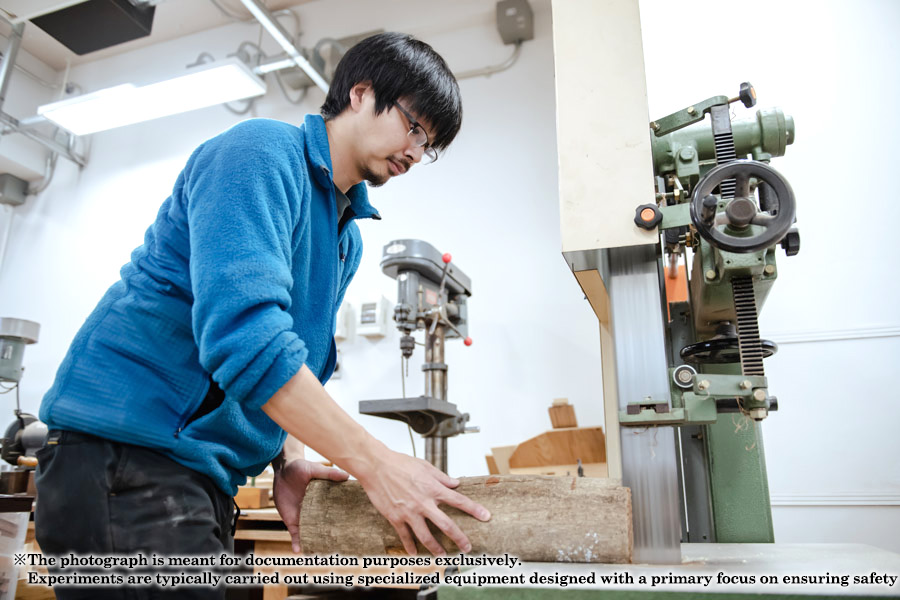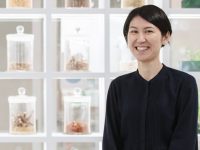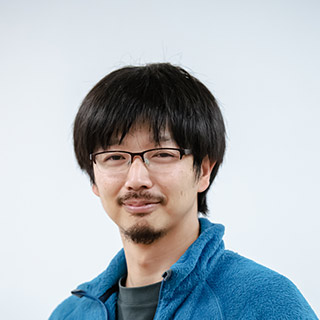As we gain a deeper understanding of forests, the awareness of the environment within society will likely increase. What kind of educational programs can be offered to children with a focus on “forests”? Jun Tanabe, Assistant Professor of the Faculty of Education, contemplates this question daily and puts his thoughts into practice. In addition to education that utilizes wood, we interviewed him about his collaborative research with the Graduate School of Horticulture on the risk of stem breakage during strong winds.
Efforts to use wood for education

―What inspired your research, “Education Material Development for Forest Cultivation and Utilization?”
I originally graduated from the Department of Forestry in the Faculty of Agriculture before coming to the Faculty of Education at Chiba University. The trigger for starting the development of educational materials was my contemplation: “Do children have opportunities to learn about forests and wood?” Upon reviewing actual textbooks, I found that the only chances for students to engage with wood were in a junior high school subject, Technology. Hence, I felt there is a need to create educational materials that encourage students to comprehensively understand wood and promote appropriate wood usage. Additionally, I recognized the importance of developing a curriculum that not only delves into the subject of wood, but also explores broader aspects, including forest management. This includes fostering an awareness of internationally recognized systems such as FSC Certification*, which endorses responsible forest management practices. Recognizing the synergy between the concepts of cultivating and utilizing forests and the vision of Sustainable Development Goals (SDGs), I aspire to encourage reflections on such societal issues through my science experiment materials.
*Forest Stewardship Council (FSC) Certification: An internationally recognized system that certifies products created under sustainable forest management to benefit the environment and society.

―Specifically, what kind of educational materials are you developing?
Recently, during a Technology and Home Economic class at a junior high school, I conducted a session where students were tasked with processing parts of the same shape using five different types of wood: Japanese cedar, Scots pine, agathis, Japanese linden, and katsura. I often explore wood materials and processing in Technology classes through projects like creating shelves. However, when only one type of wood is used to make a shelf, students might lose a chance to experience the differences based on tree species. Recognizing this, I believed that by having students engage in professing all five tree types, they would gain insights into the distinct properties of each species. Moreover, repeatedly performing the same processing tasks would foster skill mastery.
I believe that understanding the varying characteristics of different tree species can enhance the resolution in students’ perception of the world. It is just like not being able to name an unfamiliar color. Recognizing the differences between tree species could be useful when choosing their homes and furniture in the future.

Designing a program to experience experiments in forestry and wood science


What is your role in the “ASCENT Program*,” to cultivate solution-oriented next-generation talents in science and technology?
Initially, students have limited exposure to forestry or wood science experiments. Therefore, this program starts with straightforward experiments. I think it’s important for students to gain experience in obtaining some form of value from simple experiments. For example, by introducing a topic like, “Let’s think about the wind speed at which this tree would topple,” and conducting an experiment, we can derive specific outcomes, such as determining that “The tree would fall down with a wind speed of 40 meters.”
Additionally, I offer an experiment to estimate the amount of carbon stored within each tree. Tree species that grow in Japan’s four-season climate allow us to determine their age and annual growth by counting their annual rings. Taking a wood sample from a tree enables us to measure its annual rings and wood density. With a specialized tool, we can extract a small piece of wood, approximately 5 mm in diameter, from a standing tree. Assuming that the tree has a cone-like shape, we can roughly calculate approximate volumes for each age and, given the volume, calculate the weight from its wood density. As about half of the weight of dried wood is carbon, we can also estimate the amount of carbon stock. For instance, the carbon stock was 50kg five years ago and has slightly increased to 55kg now. This approach brings forth tangible results through experimentation. This emphasizes the importance of obtaining practical outcomes from such experiments.
*A thematic research course designed for 1st and 2nd-year high school students, the “ASCENT Program: Developing Future Leaders to Create Society 5.0.” Supported by the Japan Science and Technology Agency (JST), this initiative aims to cultivate globally oriented talents in the field of science and technology. Chiba University’s unique program nurtures individuals who take the lead in social transformation or who design a new society from diverse perspectives.
Aiming to deliver lessons that can capture the hearts and minds of students, even with a limited number

―Have you observed any changes in students’ behaviors or expressions that you think can be attributed to the lessons?
To be honest, I think that about 90% of the students may not fully engage with this type of class, and I’m absolutely fine with that. If the majority of the students find it somewhat interesting, then I consider it a success. Moreover, if the class could touch a few percent of students, igniting the thought, “I can actually do this! That’s pretty cool!” and inspiring them to proactively try it, I would think that would be a great outcome.
―Any new teaching materials in mind?
I would like to offer classes that inspire students to engage in deeper critical thinking. For example, we could prompt them to consider which materials should be used for various scenarios based on three perspectives: material quality, price, and durability. This approach would encourage students to think beyond the simple classification of ‘hard’ or ‘soft’ wood, allowing them to explore broader aspects, such as the economic, trade, and political conditions of that time.
In today’s world, it is common for young people to be surrounded by high-tech devices, often using them without understanding their internal mechanisms. I would like to create educational materials that can shift the perception from “I’m not sure how it functions, but it works” to “Now I see how it operates!” For instance, using the mechanical properties of specific wood types, I plan to develop experimental materials for crafting a spring scale—a device that measures mass using spring properties. My aim is to actively involve students with these materials, encouraging them to ponder differences among various wood species.
Research on trees blown down by storms

―You conduct research on the mechanism of tree trunk breakage
In 2019, Typhoon No.15 Faxai caused significant damage in Chiba Prefecture, resulting in numerous instances of tree trunk breakage. During this period, I was approached by Professor Tatsuaki Kobayashi from the Graduate School of Horticulture, who was conducting research at Cape Taibusa in Tateyama, Chiba Prefecture. I then became involved in the research. At Cape Taibusa, an evergreen broadleaf species Lithocarpus edulis were torn down. In contrast, another tree species, Ilex, located in the same area, did not experience as much breakage. I hypothesized that such variations occur due to certain factors that make tree trunks susceptible to breaking in the wind. Undoubtedly, the specific characteristics of each tree species play a significant role.
Trees grow at varying rates depending on the species, and the potential shapes they can take (tree forms) also vary among different types of trees. When considering cases in which tree shapes and trunk strengths differ, I aim to investigate the potential bottlenecks of each species.
In assessing the risk of tree falls, previous observations have shown a likely correlation between tree shape and the mechanical properties (strength) of the trunk. With this understanding, my next step is to explore the implications of this relationship. I will uncover certain factors that bridge the gap between tree form and material properties.
―Finally, please give a message to students, researchers, and professionals interested in this field.
Recently, my research themes have been branching out in diverse directions, and there are instances when I struggle to organize them cohesively. Yet, despite their seemingly disparate nature, I sense an underlying connection among these topics—a subtle interlinking that emerges. This phenomenon likely stems from the fundamental philosophical thread woven by those engaged in research. Consequently, by collectively steering our research endeavors toward the areas that arouse our curiosity, I am confident that the laboratory’s driving force will experience a notable surge. While I am currently exploring various domains of study, I extend an open invitation to anyone who might find even the slightest inkling of interest. I encourage you to reach out and connect with me. Collaborating and advancing in research together would bring me great joy.

Series
Introducing Japanese Science Education to the World
Chiba University is advancing global talent development through programs like ‘Twinkle,’ where students deliver science education in English to high-school students in ASEAN countries.
-

#1
2023.08.25
Nurturing Teaching Personnel for Multicultural Societies: High Schools-Universities-Graduate Schools’ Tripartite Collaboration to Develop Educational Programs in ASEAN Countries
-

#2
2023.08.31
Viewing a Diverse World through the Lens of Agriculture and Food: Enriching Global SDGs Education with Insights from Extensive Overseas Field Research
-

#3
2023.11.17
Reimagining the World with Tree Insights: Exploring Society through the Lens of Forests
-

#4
2023.11.24
Bringing Japan’s renowned experiment-based science education to Southeast Asia: Developing sustainable physics teaching materials for the pursuit of a disparity-free society
Recommend
-

Viewing a Diverse World through the Lens of Agriculture and Food: Enriching Global SDGs Education with Insights from Extensive Overseas Field Research
2023.08.31
-

The Joy of Work and The Delight of Nurturing: From Social Farming to Universal Farms
2025.02.10
-

Designing a Comfortable Living: A Kampo Clinic that Simulates the Five Senses
2024.01.26




